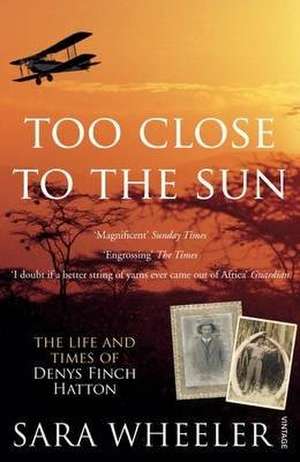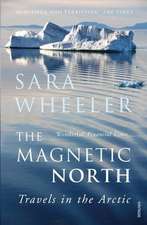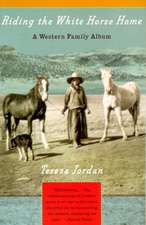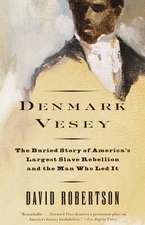Too Close To The Sun
Autor Sara Wheeleren Limba Engleză Paperback – mar 2007
| Toate formatele și edițiile | Preț | Express |
|---|---|---|
| Paperback (2) | 68.38 lei 24-35 zile | +23.56 lei 4-10 zile |
| Vintage Publishing – mar 2007 | 68.38 lei 24-35 zile | +23.56 lei 4-10 zile |
| Random House Trade – 30 iun 2009 | 120.71 lei 3-5 săpt. |
Preț: 68.38 lei
Preț vechi: 82.05 lei
-17% Nou
Puncte Express: 103
Preț estimativ în valută:
13.09€ • 14.21$ • 10.99£
13.09€ • 14.21$ • 10.99£
Carte disponibilă
Livrare economică 04-15 aprilie
Livrare express 15-21 martie pentru 33.55 lei
Preluare comenzi: 021 569.72.76
Specificații
ISBN-13: 9780099450276
ISBN-10: 0099450275
Pagini: 304
Dimensiuni: 129 x 198 x 27 mm
Greutate: 0.24 kg
Editura: Vintage Publishing
Locul publicării:United Kingdom
ISBN-10: 0099450275
Pagini: 304
Dimensiuni: 129 x 198 x 27 mm
Greutate: 0.24 kg
Editura: Vintage Publishing
Locul publicării:United Kingdom
Recenzii
“What is it about these untamable men that makes them so alluring? . . . In Finch Hatton, [Sara] Wheeler has found the archetypal wanderer forced to straddle multiple worlds. He embodies the contradictions of the early modern age and, in some ways still, of ours.”—New York Times Book Review
“A fascinating portrait of . . . a singularly romantic life.”—Vogue
“Highly recommended . . . Wheeler’s striking descriptions of East Africa, including Kenya and the Rift Valley, create a rich sense of place and time.”—Library Journal
“Wheeler’s fascinating, witty bio reveals her wonderful eye for telling details.”—Entertainment Weekly
“A fascinating portrait of . . . a singularly romantic life.”—Vogue
“Highly recommended . . . Wheeler’s striking descriptions of East Africa, including Kenya and the Rift Valley, create a rich sense of place and time.”—Library Journal
“Wheeler’s fascinating, witty bio reveals her wonderful eye for telling details.”—Entertainment Weekly
Extras
Chapter One
OUT OF TRIM
I saw him first fingering a pistol in a Nairobi gun-shop, with the casual interest that men of action will show for such toys, and well I liked the look of his scholarly appearance, which had also about it the suggestion of an adventurous wanderer, of a man who had watched a hundred desert suns splash with gilt the white-walled cities of Somaliland. —llewelyn powys, Black Laughter, 1925 When he heard that denys finch hatton had been killed on the plains of Africa, Alan Parsons reflected that his friend had been “like one of his forefathers of Elizabethan days—a man of action and a man of poetry.” It was the first Sir Christopher Hatton who had raised the family to the sunlit uplands of the English aristocracy, and they languished there through the pleasant centuries while their nation prospered. Denys inherited the charm of his Elizabethan ancestor, but not his taste for the gilded baits of conventional success. A Northamptonshire man, ruffed and sharp-bearded, Sir Christopher had worked his way into court and dazzled Queen Elizabeth with his dancing. She showered him with money and honors until he was Lord Chancellor. At thirty-five, he was able to purchase Kirby Hall in East Northamptonshire, one of the great Elizabethan houses, a model of proportion replete with cupolas, pergolas, and ninety-two fireplaces. But Sir Christopher had many mansions, and for five years he was too busy to visit Kirby. By the time Denys was born three centuries later, the family was heading in the other direction (down), as his uncle George, the eleventh Earl of Winchilsea, had gambled away several fortunes. After disposing of most of the family paintings, he sold the lead from the roof of Kirby Hall. His widowed stepmother, meanwhile, was quietly bringing up three sons and a daughter at Haverholme Priory in Lincolnshire. Frances “Fanny” Rice became the tenth earl’s third wife in 1849; their second son, Henry Stormont, was Denys’s father. At Haverholme, Henry and his siblings grew to love the pared-down landscape and the winds that sped across the flatlands freighted with the chill of the North Sea. The three boys went out with their uncles, shooting partridge in the gravel pits, pigeons in Evedon Wood, and rabbits everywhere. They caught pike up and down the Slea and dace in the section between Haverholme Lock and Cobbler’s Lock, and played golf and cricket in the park. (In the untroubled 1860s, the Priory had its own cricket team.) After boarding school Henry went up to Balliol, the Oxford college favored by the ancestral earls. At nineteen, his hollow-cheeked Renaissance face was framed by sideburns the color of sweet sherry. His nose was long and sharp, his eyes deep-set, and a prehensile mustache dipped and clung to his chin below his lower lip. Finch Hattons were speculators and adventurers. By the 1870s, young men from the landed gentry had started heading south to Australia—many were hired as jackaroos on the cattle stations—and after a year Henry gave up on Balliol and steamed to the subtropical northern tip of Queensland. He rode a horse down to Mackay, a huddle of shacks quietly sweltering among the sugar plantations 150 miles north of the Tropic of Capricorn. There he joined a maternal uncle who had sailed to Australia six years earlier. Knowing little of sugar, the pair determined to set themselves up as stockmen, and reconnaissance took them to the well-watered cattle country around Mount Spencer, forty-five miles inland. They purchased four hundred square miles of bush, at first sleeping on canvas stretchers in a hut overlooking a lagoon. Henry had a table for his tin basin and a fragment of looking glass balanced on a pair of nails driven into a post. At night, he read in the sallow glow of a fat-filled jam tin wicked with a twist of tweed from his trousers. The lure of the frontier was in the blood, and within a year Henry’s younger brother, Harold, had arrived in Queensland to assist the fledgling family firm. On his first night, he found an eleven-foot carpet snake coiled in his cot bed. But it would have taken more than a snake to deter Harold, a figure of buttonholing vigor and the most voluble of the Finch Hattons. With his brother and his uncle, he turned Mount Spencer into a comfortable village of houses and huts, and the station into a going concern with twelve thousand cattle and a permanent staff of stockmen and boys. It was hard work all around. Simply chopping timber for fences was a Sisyphean task that involved pulling a crosscut saw and swinging a maul under a vertical sun, the thermometer often reaching 110 degrees in the shade. “But if a man is thoroughly sound,” Harold wrote, “. . . it is odd if he does not look back to the time when he was splitting rails for ten hours a day as the happiest in his life.” A man with a powerful sense of public duty, Harold was quickly appointed a Queensland magistrate and later became the voice of judicial authority at the goldfields, granting (or, more often, refusing) alcohol licenses. He was a model of moral seriousness and egregious self-confidence—an imperial beau idéal.* In his spare time, he learned to throw the boomerang; he included this among his achievements in Who’s Who (“only white man who could ever throw the boomerang like the blacks of Australia”). He never married. In later years, he was close to his nephews and nieces, and Denys, the youngest, worshipped his uncle Harold, the archetypal man of action. Denys loved hearing stories of the magnificent landscapes, dizzying scale, and hazards innumerable that characterized the pioneering experience of the white men who battled the Australian bush in the last decades of the nineteenth century. For those made of the right material, it was a Garden of Eden. Thirty-five years later, Denys was to find a similar paradise on the plains of East Africa. DENYS’S MATERNAL GRANDMOTHER, Helen, had married Admiral of the Fleet Sir Henry Codrington, KC, in 1849. His father had captained the Orion at Trafalgar. After fifteen years of marriage, the admiral sued for divorce on the grounds of his wife’s multiple adulteries. The Codringtons had been living in Malta, where Sir Henry held the position of admiral-superintendent of the dockyard. Since its acquisition in 1814, Malta had been one of the great British naval bases and the home of the Royal Navy’s Mediterranean fleet. Perks of the job included a high-specification gondola, and at the divorce trial in London the gondolier testified that when Lady Codrington was escorted home by a certain officer he regularly observed his vessel “getting out of trim” due to excessive movement in the cabin. Day after day, jurors heard a litany of alleged activities, including a lesbian affair and flights from private detectives—all subsequently recounted in minute detail in the pages of The Times. It was the soap opera of the moment, and through the dog days of summer in 1864 the denizens of the Establishment gasped for the next installment. The admiral, suggested Lady Codrington in a robust counterattack, had once entered her bedchamber and groped her lady companion. Lawyers read out copious extracts from diaries and letters and, in his summing-up to the jury, the judge expressed his concern that they should not be influenced by the sheer number of charges brought against Lady Codrington—“so many imputations of criminal intercourse . . . all more or less sustained by evidence.” He pointed out that even a thousand weak links did not make a strong chain. But the jurors thought the links were strong enough, and on November 23 they found Lady Codrington guilty. Her daughters, Denys’s mother, Anne—known as Nan—and her sister, Nell, were eleven and ten. The admiral got his decree nisi. But the verdict was disputed, and, to the delight of the nation, the case rolled on. Like one of the admiral’s ships in full sail, it took a long time to stop. The two little girls, meanwhile, were shunted among relations, friends, and governesses, absorbed enough in the private world of childhood but uneasily aware of the hostilities that lay beyond its frontiers. Their mother had emerged from her husband’s testimony as a figure of lewd vulgarity. In reality, Helen Codrington, hemmed in by an existence over which she had no control, had chosen the only means of self-renewal available to her. She could not leave, so she tried to make staying tolerable; it was her way of seeking a better world. The affair was never spoken of in the family, even after many years. Denys never knew his grandmother; she died before he was born. It was a pity, as in him she would have found an ally at last. He had her affinity for waywardness, and his heart, too, never settled. HENRY FINCH HATTON met Nan Codrington when he returned from Australia on leave in 1879. Three years later, when both were thirty, they married. The bride had copper pre-Raphaelite hair, aspirin-white skin, and large gray eyes that sheltered under broad red brows. Her friends were artists and musicians, and she brought a gentle bohemian glamour to the closed and traditional Winchilsea clan. She was intimate with Ellen Terry, an actress of the grand manner who had won the country’s heart during her twenty-four-year stage partnership with Sir Henry Irving. Known to her circle as Nellie, Terry was five years older than Nan and devoted to her—a stream of genuine affection plain to see amid the thespian gush. In her memoirs, Nellie said that once, as she was preparing to play Beatrice in a new production of Much Ado About Nothing, she “began to ‘take soundings’ from life for my conception of her. I found in my friend Anne Codrington what I wanted. There was before me a Beatrice—as fine a lady as ever lived, a great-hearted woman, beautiful, accomplished, merry, tender. When Nan Codrington came into the room, the sun came out.” Many would later note the same ineffable specialness in Nan’s son Denys. John Craigie, a university friend, recalled in old age, “He has remained with me as an almost unique personality. Completely fearless, he showed kindness in all his deeds. A king among men, he never did an unworthy action.” Eleven months after their marriage, and by now back in Australia, Henry and Nan had a daughter. The proud parents could not agree on a name, so the infant was christened Gladys Margaret, names never liked by anybody, with the result that she was known, from the outset, as Topsy. Two and a half years later, a son was born: Guy Montagu George, always known as Toby. The expanding family returned to England, and there Henry and his elder brother Murray focused on their bank balance. “Everything in the family financially at as critical a point as can be imagined,” Henry wrote in his diary on January 1, 1887. The large sums that should have been available had been dissipated by their half brother, George, the eleventh earl (he had found a fresh source of revenue at the pawnshop, where he deposited his wife’s jewelry). In addition, rents nationally had fallen by a quarter between the mid-seventies and the mid-eighties, denting the income of the entire landed class. The family business in Australia had failed to bring in money and now descended into crisis. Harold, the boomerang-throwing third brother, had returned from Queensland in 1883 and embarked on a financial career in the City, so he was unable to go back to try to salvage at least some of the initial investment. It was agreed that Henry should return to Australia alone “to see to things.” This was a difficult decision, as Nan was pregnant again. She and the two children were to live in rented accommodations in London until the new baby arrived, then move up to a property on the Haverholme estate in Lincolnshire. It was a typical Finch Hatton plan; the compulsion to move house bordered on the pathological. In February 1887, Henry moved his brood into 22 Prince of Wales Terrace, a new town house in a Kensington cul-de-sac that he had taken at six guineas a week until the end of May. Haverholme Priory had to be tenanted. “Alack, HP is a thing of the past,” Henry wrote in his diary the day the maids unpacked the trunks. But it wasn’t. He held on to Haverholme for another forty years. When he really did have to let it go, the grief of it killed him. On March 9, Henry left England, comforting himself on the steamer with Thompson’s History of the Paraguayan War. Almost as soon as he arrived in Queensland, he realized that the financial prognosis was disastrous. Back in the 1870s, he and Harold had started a mining company in addition to the cattle station. Since the California rush of 1849–50, the prospector had been a familiar figure on the imperial landscape. When a vigilant opportunist from New South Wales recognized, in the Californian seams, rock formations similar to those at home, he returned to the mountains of his youth, found a mine, and triggered the Australian gold rush. After yellowy glints were spotted in a creek running off Mount Britten, on the western fall of the coastal range, Harold and Henry sank money into a mill at the diggings. With land in England no longer a gold mine—even without a gambling earl—the Finch Hattons were speculating on any possible fresh source of income. But Henry returned to find that all efforts to float the company had failed. “No sale is possible now at almost any price,” he concluded. It was not all bad news that year. Back in Prince of Wales Terrace, baby Denys was born on April 24, 1887. His eyes were topsoil-brown, and he was long. The news reached his father by cable sixteen days later. “Hurrah at last!” Henry wrote in his diary that night. “No words to express the relief and delight.” But Henry was suffering from rheumatism in his shoulder and a bad case of homesickness. “My darling Nan,” he wrote on August 15, after receiving the mail, “I thank everything [sic] seems cosy and happy . . . I do long for her so dreadfully.” Although his rheumatism turned into sciatica (“Never had so much torture in my life”), Henry managed to keep up his fishing trips, got in a spot of possum shooting, and even had a pop at the cockatoos. He was glad to see the back of the year, notwithstanding the acquisition of another son. “So ends 1887, and I hope 1888 may have more luck in store for us all,” he wrote in his diary on December 31. “It’s been a vile year for me on the whole, away from home and bothered with station affairs and minor anxieties—and mostly alone.” Then, on June 15, he learned by cable that his gambling half brother, George, had died at the age of seventy-two. “Poor dear old W. [Winchilsea],” Henry wrote in his diary. “I hope he knew how fond of him we all were. But he was always thinking we must hate him for ruin brought on the family by him.
OUT OF TRIM
I saw him first fingering a pistol in a Nairobi gun-shop, with the casual interest that men of action will show for such toys, and well I liked the look of his scholarly appearance, which had also about it the suggestion of an adventurous wanderer, of a man who had watched a hundred desert suns splash with gilt the white-walled cities of Somaliland. —llewelyn powys, Black Laughter, 1925 When he heard that denys finch hatton had been killed on the plains of Africa, Alan Parsons reflected that his friend had been “like one of his forefathers of Elizabethan days—a man of action and a man of poetry.” It was the first Sir Christopher Hatton who had raised the family to the sunlit uplands of the English aristocracy, and they languished there through the pleasant centuries while their nation prospered. Denys inherited the charm of his Elizabethan ancestor, but not his taste for the gilded baits of conventional success. A Northamptonshire man, ruffed and sharp-bearded, Sir Christopher had worked his way into court and dazzled Queen Elizabeth with his dancing. She showered him with money and honors until he was Lord Chancellor. At thirty-five, he was able to purchase Kirby Hall in East Northamptonshire, one of the great Elizabethan houses, a model of proportion replete with cupolas, pergolas, and ninety-two fireplaces. But Sir Christopher had many mansions, and for five years he was too busy to visit Kirby. By the time Denys was born three centuries later, the family was heading in the other direction (down), as his uncle George, the eleventh Earl of Winchilsea, had gambled away several fortunes. After disposing of most of the family paintings, he sold the lead from the roof of Kirby Hall. His widowed stepmother, meanwhile, was quietly bringing up three sons and a daughter at Haverholme Priory in Lincolnshire. Frances “Fanny” Rice became the tenth earl’s third wife in 1849; their second son, Henry Stormont, was Denys’s father. At Haverholme, Henry and his siblings grew to love the pared-down landscape and the winds that sped across the flatlands freighted with the chill of the North Sea. The three boys went out with their uncles, shooting partridge in the gravel pits, pigeons in Evedon Wood, and rabbits everywhere. They caught pike up and down the Slea and dace in the section between Haverholme Lock and Cobbler’s Lock, and played golf and cricket in the park. (In the untroubled 1860s, the Priory had its own cricket team.) After boarding school Henry went up to Balliol, the Oxford college favored by the ancestral earls. At nineteen, his hollow-cheeked Renaissance face was framed by sideburns the color of sweet sherry. His nose was long and sharp, his eyes deep-set, and a prehensile mustache dipped and clung to his chin below his lower lip. Finch Hattons were speculators and adventurers. By the 1870s, young men from the landed gentry had started heading south to Australia—many were hired as jackaroos on the cattle stations—and after a year Henry gave up on Balliol and steamed to the subtropical northern tip of Queensland. He rode a horse down to Mackay, a huddle of shacks quietly sweltering among the sugar plantations 150 miles north of the Tropic of Capricorn. There he joined a maternal uncle who had sailed to Australia six years earlier. Knowing little of sugar, the pair determined to set themselves up as stockmen, and reconnaissance took them to the well-watered cattle country around Mount Spencer, forty-five miles inland. They purchased four hundred square miles of bush, at first sleeping on canvas stretchers in a hut overlooking a lagoon. Henry had a table for his tin basin and a fragment of looking glass balanced on a pair of nails driven into a post. At night, he read in the sallow glow of a fat-filled jam tin wicked with a twist of tweed from his trousers. The lure of the frontier was in the blood, and within a year Henry’s younger brother, Harold, had arrived in Queensland to assist the fledgling family firm. On his first night, he found an eleven-foot carpet snake coiled in his cot bed. But it would have taken more than a snake to deter Harold, a figure of buttonholing vigor and the most voluble of the Finch Hattons. With his brother and his uncle, he turned Mount Spencer into a comfortable village of houses and huts, and the station into a going concern with twelve thousand cattle and a permanent staff of stockmen and boys. It was hard work all around. Simply chopping timber for fences was a Sisyphean task that involved pulling a crosscut saw and swinging a maul under a vertical sun, the thermometer often reaching 110 degrees in the shade. “But if a man is thoroughly sound,” Harold wrote, “. . . it is odd if he does not look back to the time when he was splitting rails for ten hours a day as the happiest in his life.” A man with a powerful sense of public duty, Harold was quickly appointed a Queensland magistrate and later became the voice of judicial authority at the goldfields, granting (or, more often, refusing) alcohol licenses. He was a model of moral seriousness and egregious self-confidence—an imperial beau idéal.* In his spare time, he learned to throw the boomerang; he included this among his achievements in Who’s Who (“only white man who could ever throw the boomerang like the blacks of Australia”). He never married. In later years, he was close to his nephews and nieces, and Denys, the youngest, worshipped his uncle Harold, the archetypal man of action. Denys loved hearing stories of the magnificent landscapes, dizzying scale, and hazards innumerable that characterized the pioneering experience of the white men who battled the Australian bush in the last decades of the nineteenth century. For those made of the right material, it was a Garden of Eden. Thirty-five years later, Denys was to find a similar paradise on the plains of East Africa. DENYS’S MATERNAL GRANDMOTHER, Helen, had married Admiral of the Fleet Sir Henry Codrington, KC, in 1849. His father had captained the Orion at Trafalgar. After fifteen years of marriage, the admiral sued for divorce on the grounds of his wife’s multiple adulteries. The Codringtons had been living in Malta, where Sir Henry held the position of admiral-superintendent of the dockyard. Since its acquisition in 1814, Malta had been one of the great British naval bases and the home of the Royal Navy’s Mediterranean fleet. Perks of the job included a high-specification gondola, and at the divorce trial in London the gondolier testified that when Lady Codrington was escorted home by a certain officer he regularly observed his vessel “getting out of trim” due to excessive movement in the cabin. Day after day, jurors heard a litany of alleged activities, including a lesbian affair and flights from private detectives—all subsequently recounted in minute detail in the pages of The Times. It was the soap opera of the moment, and through the dog days of summer in 1864 the denizens of the Establishment gasped for the next installment. The admiral, suggested Lady Codrington in a robust counterattack, had once entered her bedchamber and groped her lady companion. Lawyers read out copious extracts from diaries and letters and, in his summing-up to the jury, the judge expressed his concern that they should not be influenced by the sheer number of charges brought against Lady Codrington—“so many imputations of criminal intercourse . . . all more or less sustained by evidence.” He pointed out that even a thousand weak links did not make a strong chain. But the jurors thought the links were strong enough, and on November 23 they found Lady Codrington guilty. Her daughters, Denys’s mother, Anne—known as Nan—and her sister, Nell, were eleven and ten. The admiral got his decree nisi. But the verdict was disputed, and, to the delight of the nation, the case rolled on. Like one of the admiral’s ships in full sail, it took a long time to stop. The two little girls, meanwhile, were shunted among relations, friends, and governesses, absorbed enough in the private world of childhood but uneasily aware of the hostilities that lay beyond its frontiers. Their mother had emerged from her husband’s testimony as a figure of lewd vulgarity. In reality, Helen Codrington, hemmed in by an existence over which she had no control, had chosen the only means of self-renewal available to her. She could not leave, so she tried to make staying tolerable; it was her way of seeking a better world. The affair was never spoken of in the family, even after many years. Denys never knew his grandmother; she died before he was born. It was a pity, as in him she would have found an ally at last. He had her affinity for waywardness, and his heart, too, never settled. HENRY FINCH HATTON met Nan Codrington when he returned from Australia on leave in 1879. Three years later, when both were thirty, they married. The bride had copper pre-Raphaelite hair, aspirin-white skin, and large gray eyes that sheltered under broad red brows. Her friends were artists and musicians, and she brought a gentle bohemian glamour to the closed and traditional Winchilsea clan. She was intimate with Ellen Terry, an actress of the grand manner who had won the country’s heart during her twenty-four-year stage partnership with Sir Henry Irving. Known to her circle as Nellie, Terry was five years older than Nan and devoted to her—a stream of genuine affection plain to see amid the thespian gush. In her memoirs, Nellie said that once, as she was preparing to play Beatrice in a new production of Much Ado About Nothing, she “began to ‘take soundings’ from life for my conception of her. I found in my friend Anne Codrington what I wanted. There was before me a Beatrice—as fine a lady as ever lived, a great-hearted woman, beautiful, accomplished, merry, tender. When Nan Codrington came into the room, the sun came out.” Many would later note the same ineffable specialness in Nan’s son Denys. John Craigie, a university friend, recalled in old age, “He has remained with me as an almost unique personality. Completely fearless, he showed kindness in all his deeds. A king among men, he never did an unworthy action.” Eleven months after their marriage, and by now back in Australia, Henry and Nan had a daughter. The proud parents could not agree on a name, so the infant was christened Gladys Margaret, names never liked by anybody, with the result that she was known, from the outset, as Topsy. Two and a half years later, a son was born: Guy Montagu George, always known as Toby. The expanding family returned to England, and there Henry and his elder brother Murray focused on their bank balance. “Everything in the family financially at as critical a point as can be imagined,” Henry wrote in his diary on January 1, 1887. The large sums that should have been available had been dissipated by their half brother, George, the eleventh earl (he had found a fresh source of revenue at the pawnshop, where he deposited his wife’s jewelry). In addition, rents nationally had fallen by a quarter between the mid-seventies and the mid-eighties, denting the income of the entire landed class. The family business in Australia had failed to bring in money and now descended into crisis. Harold, the boomerang-throwing third brother, had returned from Queensland in 1883 and embarked on a financial career in the City, so he was unable to go back to try to salvage at least some of the initial investment. It was agreed that Henry should return to Australia alone “to see to things.” This was a difficult decision, as Nan was pregnant again. She and the two children were to live in rented accommodations in London until the new baby arrived, then move up to a property on the Haverholme estate in Lincolnshire. It was a typical Finch Hatton plan; the compulsion to move house bordered on the pathological. In February 1887, Henry moved his brood into 22 Prince of Wales Terrace, a new town house in a Kensington cul-de-sac that he had taken at six guineas a week until the end of May. Haverholme Priory had to be tenanted. “Alack, HP is a thing of the past,” Henry wrote in his diary the day the maids unpacked the trunks. But it wasn’t. He held on to Haverholme for another forty years. When he really did have to let it go, the grief of it killed him. On March 9, Henry left England, comforting himself on the steamer with Thompson’s History of the Paraguayan War. Almost as soon as he arrived in Queensland, he realized that the financial prognosis was disastrous. Back in the 1870s, he and Harold had started a mining company in addition to the cattle station. Since the California rush of 1849–50, the prospector had been a familiar figure on the imperial landscape. When a vigilant opportunist from New South Wales recognized, in the Californian seams, rock formations similar to those at home, he returned to the mountains of his youth, found a mine, and triggered the Australian gold rush. After yellowy glints were spotted in a creek running off Mount Britten, on the western fall of the coastal range, Harold and Henry sank money into a mill at the diggings. With land in England no longer a gold mine—even without a gambling earl—the Finch Hattons were speculating on any possible fresh source of income. But Henry returned to find that all efforts to float the company had failed. “No sale is possible now at almost any price,” he concluded. It was not all bad news that year. Back in Prince of Wales Terrace, baby Denys was born on April 24, 1887. His eyes were topsoil-brown, and he was long. The news reached his father by cable sixteen days later. “Hurrah at last!” Henry wrote in his diary that night. “No words to express the relief and delight.” But Henry was suffering from rheumatism in his shoulder and a bad case of homesickness. “My darling Nan,” he wrote on August 15, after receiving the mail, “I thank everything [sic] seems cosy and happy . . . I do long for her so dreadfully.” Although his rheumatism turned into sciatica (“Never had so much torture in my life”), Henry managed to keep up his fishing trips, got in a spot of possum shooting, and even had a pop at the cockatoos. He was glad to see the back of the year, notwithstanding the acquisition of another son. “So ends 1887, and I hope 1888 may have more luck in store for us all,” he wrote in his diary on December 31. “It’s been a vile year for me on the whole, away from home and bothered with station affairs and minor anxieties—and mostly alone.” Then, on June 15, he learned by cable that his gambling half brother, George, had died at the age of seventy-two. “Poor dear old W. [Winchilsea],” Henry wrote in his diary. “I hope he knew how fond of him we all were. But he was always thinking we must hate him for ruin brought on the family by him.
Notă biografică
Like Denys Finch Hatton, Sara Wheeler was educated at Brasenose College, Oxford. Her books include Terra Incognita: Travels in Antarctica; Travels in a Thin Country; and Cherry: A Life of Apsley Cherry-Garrard, all available from the Modern Library. When not traveling, Wheeler lives with her family in London.

















